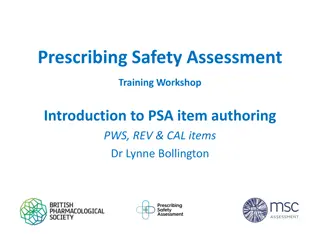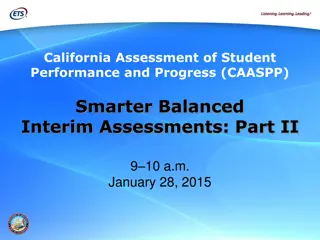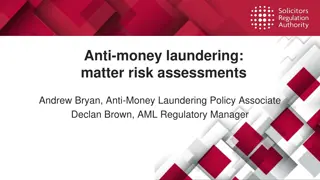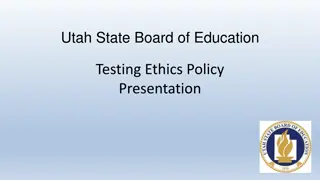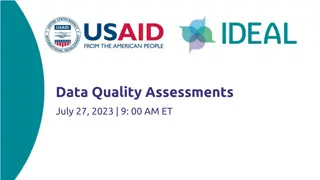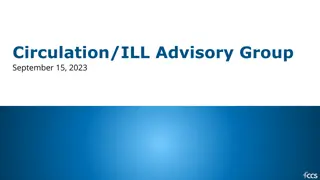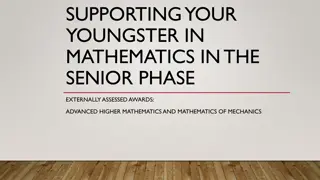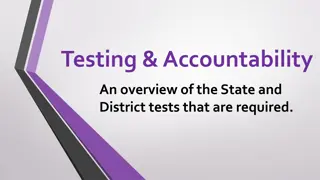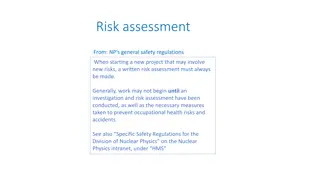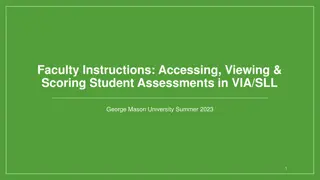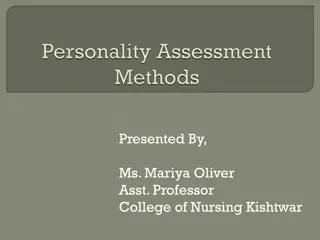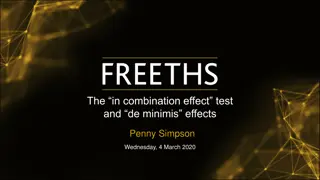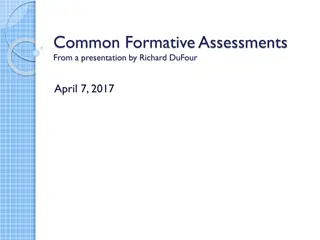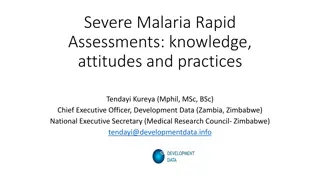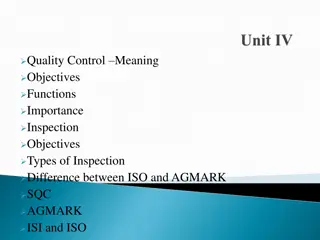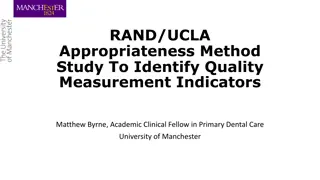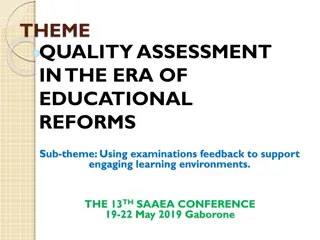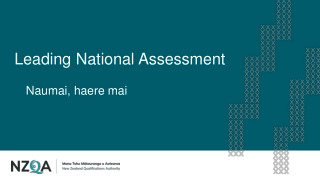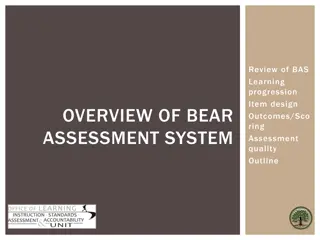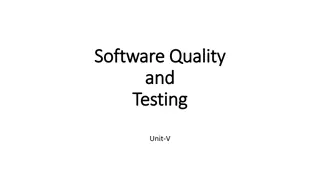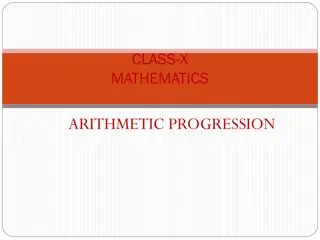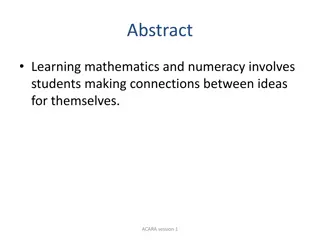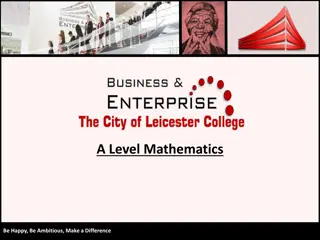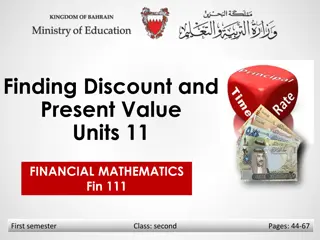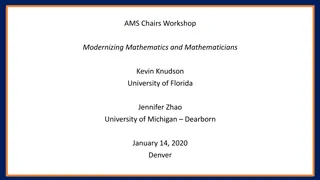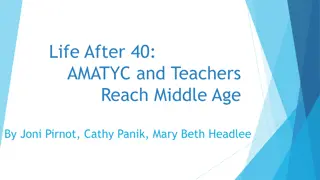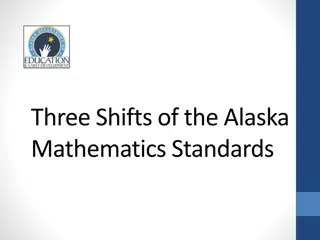Assessing Item Quality in Mathematics Assessments
Explore different types of items used in assessing quality outcomes in mathematics assessments including classification of item types, scoring methods, and selected response checklist for assessing the effectiveness and relevance of items. Learn about the advantages and disadvantages of using multiple-choice questions in assessments and best practices for constructing quality items.
Download Presentation

Please find below an Image/Link to download the presentation.
The content on the website is provided AS IS for your information and personal use only. It may not be sold, licensed, or shared on other websites without obtaining consent from the author. Download presentation by click this link. If you encounter any issues during the download, it is possible that the publisher has removed the file from their server.
E N D
Presentation Transcript
MATH ITEM TYPES Item types Assessing item quality
4 BUILDING BLOCKS Learning Progression Item Design Assessment Quality Outcomes/ Scoring
ITEM TYPES Classification of item types: Objective Performance based Item types (SBAC, 2012, pp. 27 32): Selected response (SR) Constructed response (CR) Extended response (ER) Technology-enhanced item (TE) Performance task (PT)
CLASSIFICATIONS OF ITEMS Objective Subjective/ Performance based Selected Response : True/False Multiple choice Constructed (restricted ) response: Short answer Technology-enhanced Extended response: Essay Performance task: Group/individual Project/portfolio Class participation Peer assessment
SELECTED RESPONSE (SR) Contain a set of options from which to select correct response(s) Checklist: Does the item assess an important aspect of the standard? Does the stem ask a direct question or set of specific problem? Is the item based on a paraphrase rather than words lifted directly from a textbook? Are the vocabulary and sentence structure at a relatively low and nontechnical level?
SELECTED RESPONSE (SR) Checklist (continued): Is each alternative (stem) plausible so that a student who lacks of knowledge of the correct answer cannot view it as absurd or silly? If possible, is every incorrect alternatives based on a common student error or misconception? Is the correct answer of the item independent of the correct answers of the other items? Is there only one correct or best answer to the item?
SR: MULTIPLE CHOICE Advantages Disadvantages Dos and Don ts Ease and objectivity in scoring Can assess a number of learning targets Focus on reading and thinking Less chance of randomly guessing answers than in T/F items Incorrect response(s) may indicate misconceptions May only assess lower- level thinking, if poorly written Discourage students from expressing own solutions Limited sampling of content Difficult to construct distinct and meaningful incorrect responses Write the question or task clearly by focusing it on specific learning target(s) Write the correct answer along with concise and unambiguous incorrect responses Write plausible incorrect responses (i.e. not obviously wrong responses) Avoid using all/none of the above or a combination of correct answers as alternatives Avoid using negative or double negative statements
EXAMPLE 1: POOR AND BETTER Mia has bought 4 gallons of apple juice to share with her class at school. If she plans to save 1/4 gallon for her sister at home, how many 8-ounce cups of juice can she serve? Poor: a. 576 b. 52 c. 5 d. 350 Better: a. 50 b. 52 c. 56 d. 64 Wrong answers are too obviously wrong Distractors are close enough to the correct answers. Answer: Total juice to share: (3.25x128)/8=52
EXAMPLE 2: POOR AND BETTER Poor: John runs 3 miles most mornings. Which could not be the number of miles that John has not run after several days? a. 2 b. 5 c. 9 d. 10 Double negatives Better: John runs 3 miles most mornings. Which could be the number of miles that John has run after several days? a. 2 b. 5 c. 9 d. 10
CONSTRUCTED RESPONSE (CR) Require student to generate a response in one or more words Checklist: Does the item assess an important aspect of the standard? Is the item based on a paraphrase rather than sentence copied from a book? Is the item worded clearly so that the correct answer is a brief phrase, single word of single number?
CONSTRUCTED RESPONSE (CR) Checklist, continued: Is the blank or answer space toward the end of the sentence? Are there only one or two blanks? If the item is in the completion format, is the omitted word an important word rather than a trivial word? If appropriate, does the item (or the directions) inform the appropriate degree of detail, specificity, precision, or units that the answer should have? Does the item avoid grammatical (and other irrelevant) clues to the correct answer?
CR: SHORT ANSWER Advantages Easy construction of question Disadvantages May not be able to anticipate all possible answers Dos and Don ts Carefully choose correct wordings of question so that the required answer is both brief and specific Ease and objectivity in scoring May only assess lower-level thinking Do not form a question based on a direct copy of statements from textbook Harder to measure complex learning outcomes Less chance given to students in guessing the answer Give enough indication of type of answer wanted
EXAMPLE 1: POOR AND BETTER Poor: Milani wants to build a fence around her rectangular garden. If her garden is 7 feet by 6 feet square feet and she has 45 feet of wire fence, then ______ wire fence will be left over. Unclear wording Better: Milani wants to build a fence around her rectangular garden. If her garden is 7 feet by 6 feet square feet and she has 45 feet of wire fence, a. she will need ____ feet of wire fence to surround her garden. b. there will be ____ feet of wire fence left over.
EXAMPLE 2: POOR AND BETTER Poor: Don runs 4 miles every morning in a soccer field near his house. After 5 days, he stops running because he moves to another city. What is the total miles he has run? Too wordy, unnecessary information Better: Don runs 4 miles every morning. After 5 days, he has run for ____ miles in total.
CR : RESTRICTED RESPONSE ESSAY Advantages Disadvantages Dos and Don ts Easy construction of question Can measure complex learning skills Assess and improve high- order thinking Can positively influence students studying strategies Time- consuming and error in scoring Construct questions that can assess behavior specified in the learning outcomes Phrase the question so that the student s task is clearly indicated Indicate an approximate time limit for each question Avoid the use of optional question Limited sampling of content
EXTENDED RESPONSE (ER) Require student to provide more elaborate answers and explanations of reasoning For grade 6-8 students, math items/tasks should be able to be done without calculator use Checklist: Does the item assess an important aspect of one or a set of standards? How does the item tap into the level of depth of knowledge as defined by the taxonomy? Does the item require students to apply their knowledge to a new or novel situation?
EXTENDED RESPONSE (ER) Checklist, cont d: Does the item define the tasks with specific directions and focus? Is the prompt worded in a way that students can interpret the intended task? Does the prompt give clear information on the length of answers/writing, purpose, time needed, and basis on which the answers will be scored? If the item is on a controversial matter, does the prompt make it clear that the assessment will be based on the logic and evidence supporting the argument, rather than on the actual position taken?
ER: EXTENDED RESPONSE Advantages Disadvantages Dos and Don ts Easy construction of question Can measure complex learning skills Assess and promote high-order thinking Can positively influence students studying strategies Time-consuming and error in scoring Construct questions that can assess behavior specified in the learning outcomes Phrase the question so that the student s task is clearly indicated Indicate an approximate time /word limit for each question Avoid the use of optional question Unlimited sampling of content Possible multiple answers unreliable
EXAMPLE: POOR AND BETTER Poor: By looking at the data in the table on the next page, do students who have high Biology scores also have high Math scores? Doesn t provide enough instruction for students Better: (a) Construct a scatterplot from the the table on the next page, using the graph paper provided. (b) Determine if there is a linear association between the two types of scores. (c) Explain the direction of the association. (d) Define what an outlier is, and determine from the scatterplot if there is such an outlier in the given data.
DATA AND GRAPH PAPER FOR ER ITEM Math Math 27 42 41 43 47 63 63 65 67 70 71 61 71 72 67 Biology Biology 58 73 47 54 56 70 56 76 60 79 73 68 72 78 70 This is the correct scatterplot
PERFORMANCE TASK (PT) Require students to do an activity to integrate their knowledge and skills across multiple content standards Must use clearly defined assessment criteria to evaluate how well a student has achieved the expected standards Checklist: Does the item assess an important aspect of one or a set of standards? Does the item require students to use a curriculum specified thinking process?
PERFORMANCE TASK (PT) Checklist, cont d: Is the item feasible to be done within the allocated time? Does the item define the tasks with clear directions and focus? Is the prompt worded in a way that students can interpret the intended task? Does the prompt give clear information on the expected product? Does the item allow for multiple points of view and interpretations, as intended?
EXAMPLE ITEM Mia, Jane and Kayla go to Starlight Caf every Sunday. The menu is provided below. Each of them normally orders a complete meal and has $20.00 to spend. A complete meal has one item from each section of the menu. They each want different combinations of items. Show a complete menu for each girl. Be sure to: Give a different combination of menu items for each girl. Use one item from each section of the menu for each girl. Show that the cost of each meal is $20 or less Starlight Caf Starlight Caf Appetizers Appetizers Curly Fries Vegetable Spring rolls Fried prawn skewers $ 3.45 $ 2.75 $ 3.95 Salads Salads Mango salad House salad Tofu salad $ 4.25 $ 3.00 $ 2.75 Main Course Main Course T-Bone steak Chicken Le Cordon Blue Vegetarian platter $12.15 $10.75 $ 8.00 Dessert Dessert Hot Lava chocolate mousse $ 2.25 Black forest cake slice Banana split ice cream $ 1.95 $ 2.50 All prices are subject to 5% tax
PT: PROJECT/PORTFOLIO Advantages Disadvantages Dos and Don ts Demonstrate student s best work Time-consuming and error in scoring Use and hand out a scoring rubric or performance criteria to students well in advance Assess educational growth of each student Demonstrate evidence of subject-master mastery Obtain more than one rater/marker, if possible
PT: PEER ASSESSMENT Advantages Disadvantages Dos and Don ts Error in scoring Assess students real capacity in day-to-day basis Improve student engagement Use and hand out a scoring rubric or performance criteria to students well in advance Obtain more than one rater/marker, if possible Enhance academic self- belief and motivation in learning
TECHNOLOGY-ENHANCED (TE) Require student to use a technological tool to provide answer May not be feasible for day-to-day classroom assessment Item types can be of selected response or constructed response with short or brief answers
ASSESSING ITEM QUALITY Blueprint/LP/content review Alignment between standards and proposed items Predicted item difficulty versus actual difficulty Item panel Validity evidence
ITEM BLUEPRINT For each item given, teacher should be able to: explain its relationship to the framework, justify that it is appropriately expressed for the students, generate the sort of information as intended, and ensure that the sorts of responses it elicits can be scored using the scoring guide. Sample test blueprint Standards Standards Item/ Item/ Task Task Standard 1 Standard 1 Standard 2 Standard 2 Standard 3 Standard 3 Item 1 v Item 2 v v Item 3 v
ITEM PANEL Definition Judgment or review of the quality of items by same subject teachers or subject-matter expert(s) Activities Check if the item has measured the intended learning/assessment target (standard) at appropriate level of difficulty and depth of knowledge Review the proposed item location along the LP map
VALIDITY EVIDENCE Think-aloud cognitive interviews (with example) Ask students to verbally identify their thinking process while doing the item Evaluate if students understanding of the item are as expected Exit interview Collect students opinion about the set of items Typical questions: Which item do you find it the least difficult? Why? Which item do you find it the most difficult? Why? Can you give a constructive feedback on how to improve the test? These questions may also be posed at the end of every test/learning session (change item into topic )
BIBLIOGRAPHY Nitko, A. J., & Brookhart, S. (2007). Educational assessment of students. Upper Saddle River, NJ: Pearson Education, Inc. McMillan, J. H. (2007). Classroom assessment. Principles and practice for effective standard-based instruction (4th ed.). Boston: Pearson - Allyn & Bacon. Oregon Department of Education. (2014, June). Assessment guidance. Wihardini, D. (2010). Assessment development I. Unpublished manuscript. Research and Development Department, Binus Business School, Jakarta, Indonesia. Wilson, M. (2005). Constructing measures: An item response modeling approach. New York: Psychology Press, Taylor & Francis Group. Wilson, M., & Sloane, K. (2000). From principles to practice: An embedded assessment system. Applied Measurement in Education, 13 (2), pp. 181-208. Smarter Balanced Assessment Consortium. (2012, April). General item specifications.
CREATIVE COMMONS LICENSE Item Types (Math) PPT by the Oregon Department of Education and Berkeley Evaluation and Assessment Research Center is licensed under a CC BY 4.0. You are free to: You are free to: Share Share copy and redistribute the material in any medium or format Adapt Adapt remix, transform, and build upon the material Under the following terms: Under the following terms: Attribution Attribution You must give appropriate credit, provide a link to the license, and indicate if changes were made. You may do so in any reasonable manner, but not in any way that suggests the licensor endorses you or your use. NonCommercial NonCommercial You may not use the material for commercial purposes. ShareAlike ShareAlike If you remix, transform, or build upon the material, you must distribute your contributions under the same license as the original. Oregon Department of Education welcomes editing of these resources and would greatly appreciate being able to learn from the changes made. To share an edited version of this resource, please contact Cristen McLean, cristen.mclean@state.or.us.



